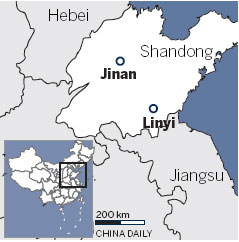Nature forms a gallery of cave art
 |
|
Yishui is home to hundreds of karst caves, the largest cluster in northern China. Ju Chuanjiang/China Daily |
For those who are looking for an opportunity to go caving, various underground caves in Yishui county, East China's Shandong province, are ideal places where adventurers are treated to a majestic display of nature's hidden works of art.
About four hours' drive from the provincial capital of Jinan, Yishui is home to hundreds of natural karst caves, which have a length ranging from several hundred meters to nearly 10 km, known as the largest karst cave cluster in terms of scale in northern China.
Experts say these caves came into being between 65 million and 450 million years ago through crust movements and corresponding intermittent evolution.
An imposing one is the Yishui Underground Gallery, where nature acts like an artist who has spent millions of years working to shape the amazing geological landscapes.
Dripstones drop from the ceilings and stone waterfalls cascade down the walls, while stalagmites rise from the ground and stone flowers blossom everywhere, giving testimony to the awesome power of nature.
"With a length of more than 6.6 km (only half is open to visitors), the cave features more than 18 types of stalactites, including the rare helictite and goosenecks," says Zhang Jing, a tour guide for six years at the scenic spot.
"The cave was widely regarded as a karst museum as it covers almost all types of stalactites yet found in the world," Zhang adds.

Each formation has been given monikers according to the men or beasts they are said to resemble.
There are the "dragon flying in the sky", "turtle scouting the sea" and "eagle standing on the mountain", as well as a huge "Buddha" formed by hundreds of stalagmites.
One of the most magnificent features is a cauliflower-shaped crystal-clear stalactite, measuring 4 meters in length and 1 meter in width. It is said to be one of only a handful of its kind of rock formations ever discovered in a Chinese limestone cave.
"The stalactite was believed to have been formed by ground water that gradually dissolved the cave's limestone as the tide rose. It grows only one centimeter a century, so you can imagine how many years it had taken for such a large creation," says Zhang.
To this day the gallery of art continues growing and changing.
A 10-km-long subterranean river runs through the cave, which is by far the longest of its kind found in the province.
Making use of the serpentine course of the river, a 1,200-meter-long thrilling underground whitewater rafting project has been built, providing much fun for anyone with a spirit of adventure.
But, for those who are keen on romantic scenes, the caves in Yishui also won't let them down.
Underground Firefly Lake, which is only 15-minute-drive from the underground gallery, will be exactly what you are looking for.
Subterranean rivers flow into the karst cave and converge into a lake of 25,000 square meters. With proper humidity and a temperature of around 12 C all year round, the cave is now a perfect habitat for millions of fireflies.





















